
Professional wrestling is a repetitive business. If something works, why not try it again a few years, or a few months, later?
Sometimes WWE likes to let audiences forget particular storylines or matches before trying them again, and sometimes the company likes to stick with a particular winning lottery number for as long as it can.
The following 10 matches are examples of the latter; each of these is a match WWE featured on a WrestleMania broadcast, then repeated in some form at its next pay-per-view event. Some of these gave performers more time to breathe and more tools to put on a good show, some were hampered by other circumstances, and some were just doomed by the law of diminishing returns.
Insane Vince McMahon ideas that got canceled - Watch Here!
Note: some of these rematches, just like The Miz's invoking of his rematch clause to take on Seth Rollins at this year's Backlash event, feature combinations of performers who were involved in multi-person or multi-team matches at WrestleMania before narrowing down their competition at the next premium show.
#10. Bret Hart vs. Steve Austin III
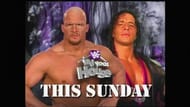
At WrestleMania 13, Bret Hart and Steve Austin put on one of the greatest matches not just in WrestleMania history, but in WWF/E history as well. Gallons of ink, trillions of pixels, and hours of podcast time have dissected this match's greatness, and deservedly so, as the contest earned its spot in the pantheon of professional wrestling history.
Sensing lightning in a bottle, WWE attempted to strike a second time by booking Hart and Austin to close out its April 20, 1997, pay-per-view, In Your House: Revenge of the Taker. In the four weeks between WrestleMania and In Your House, lots had changed about the dynamic between the two foes.
Hart cemented the heel turn he began in the finish of the WrestleMania contest by reuniting with his estranged brother Owen and brother-in-law, Davey Boy Smith, to form a new bad guy faction called The Hart Foundation, named after the tag team Hart had with another brother-in-law, Jim "The Anvil" Neidhart, in the 1980s and 1990s; Neidhart would return to join the group as 1997 wore on.
While America was the Hart Foundation's chief complaint, Austin was their main target, and the antagonism between the group's leader and the Texas Rattlesnake amplified throughout the spring, bringing an In Your House rematch with a World Wrestling Federation championship opportunity on the line.
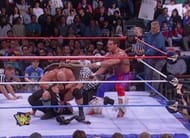
Austin would win by disqualification, when Davey Boy Smith interfered and hit Austin with a steel chair; the rest of the Foundation then tried to attack Austin with chairs and the ring bell but, in a reversal of the WrestleMania finish, Austin attacked Bret's legs, then placed The Hitman in his own signature sharpshooter until officials pulled him away, this time to raucous cheers from the Rochester, NY, crowd.
Which Worked Better?
WrestleMania, by far; while the rematch was far from a stinker (***3/4 from wrestling's Roger Ebert, Dave Meltzer), it couldn't compete with the WrestleMania match's five-star rating. Further, the rematch was nowhere near as important as its extracurriculars; while WrestleMania used a match to build a finish, In Your House used a finish to justify a match, and let Austin's attack on Bret's legs become the storyline justification for Bret's knee problems and hiatus from in-ring action (though he would continue to be an onscreen character throughout the spring and summer).
#9. Undertaker and Kane set the world (and each other) on fire
At WrestleMania XIV, The Undertaker broke months of silence to lay waste to a dominant foe who had been calling out The Deadman for weeks and months on RAW is WAR (sound familiar?). Using multiple Tombstones, the last of which just barely put down The Big Red Machine, The Undertaker left Boston the victor, but Kane and his evil manager, handler, and father Paul Bearer continued to antagonize WWE's resident phenom.
Playing off the kayfabe backstory between the demented brothers, Bearer would continue to harangue Undertaker over the mortuary fire Undertaker allegedly caused which killed Undertaker and Kane's parents and which left The Big Red Machine scarred for life, both physically and emotionally.
Bearer would vow to burn Undertaker alive, just like Undertaker had maimed his parents and little brother, and originated the Inferno Match on April 26, 1998, Unforgiven: In Your House. The match would be contested in a ring surrounded by flames, and the winner would be the first man to cause his opponent to become engulfed in fire.
The match was very similar to the WrestleMania contest, featuring lots of power offense, rest holds, and strikes from both men; Undertaker threw Kane out of the ring, where Vader (whom Kane had maimed with a wrench earlier in the year) fought to keep the Demon at ringside. Undertaker leaped over the top rope with an impressive fiery plancha, an image which singlehandedly justified the match's stipulation.
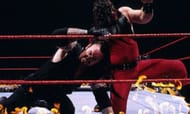
Undertaker would fight off interference from Bearer to boot his baby brother into the flames, and Kane would grip the burners with his gloved hand, causing the one-sleeved arm of his ring gear to catch fire, and give Undertaker a second consecutive win over the Devil's Favorite Demon.
Which Worked Better?
While neither match is exactly Omega vs. Okada, they both had their own marketable mystique, and it's easy to see why Undertaker vs. Kane would be one of the top programs to define the World Wrestling Federation in 1998, helping the WWF tip the rating war in its favor. Because of the hot Greensboro, SC, crowd, the interference spots from Vader and Bearer, and that literally hellish plancha (not to mention Jim Ross's memorable call of Undertaker leaping through hellfire and brimstone), Unforgiven manages to outdo its WrestleMania original.
#8. The first Backlash pay-per-view looks awfully familiar
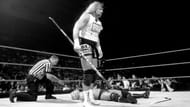
Backlash 1999, the first of nearly a dozen April/May pay-per-view events which would follow WrestleMania for years to come, featured three matches which fit this category. Two were direct rematches from WrestleMania XV with new stipulations added, while another simplified a multi-man match to the contest WrestleMania should have featured.
On the undercard, Al Snow and Hardcore Holly fought over the Hardcore Championship, having clashed the previous month with Billy Gunn in the mix (though Gunn's partner, Road Dogg, had been deeply involved in the Hardcore Championship story, and Gunn had been working the contenders for the Intercontinental Championship, which Road Dogg was now wrestling for, because Vince Russo).
Snow and Holly got more than double the time they got at WrestleMania, and managed to incorporate the all-over-the-arena wackiness most people associate with the Hardcore Title; in the end, Snow decked Holly with Head to take the championship back from his bleach-blond antagonist.
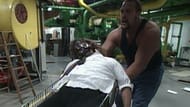
The second rematch saw Mankind continue his ongoing feud with recent WCW defector "The Big Show" Paul Wight (as he was still known at the time; Wight's real name would be dropped by year's end). The pair had wrestled to a disqualification finish at WrestleMania, giving Mankind the ability to referee that show's main event, and continued their feud despite a de facto alliance that formed when Wight was kicked out of The Corporation for attacking Vince McMahon.
Mick Foley discussed this match at length in Have A Nice Day, his first autobiography; in it, he explained that he had some time off for medical reasons in the near future, and wanted to take it easy despite the hardcore stipulations of the match. To compensate, Foley recruited Hollywood special effects artists to help create artificial weapons, steam, and even fake blood to sell the intensity of the match. Foley won before being attacked by Corporation members Test and The Big Boss Man; Mankind and The Big Show would immediately set aside their differences to retaliate, sending the segment to its finish with Test in the Mandible Claw.
The main event, however, took WrestleMania XV's main event and just slightly tweaked its cast of characters, replacing special guest referee Mankind with Shane McMahon; this being an Austin storyline in the late 1990s, the simple presence of McMahons and their monied posse is enough to explain the story leading into another Rock and Austin pay-per-view clash.
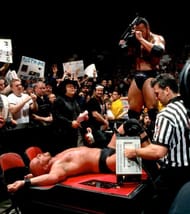
A standard Vince Russo gaga match, this No Disqualification affair featured plenty of interference, weapon shots (both the WWF title and Austin's stolen Smoking Skull variation make regular contact with combatants' skulls), and easily one of the top Stone Cold Stunners of all time, as Austin hit the move on The Rock while Rock held a television broadcast camera at ringside, sending both men through the announce table.
Which Worked Better?
All three contests far surpassed their WrestleMania original in terms of crowd reaction and critical reception; Providence, RI, was right in the WWF's backyard, and the audience showed why this time period is considered the hottest in the company's history. Additionally, the moment where Austin delivered his finisher to a broadcast-hijacking Rock has to be one of the greatest moments on any non-big-four pay-per-view.
#7. Backlash 2000 pares down WrestleMania 2000's multi-person madness
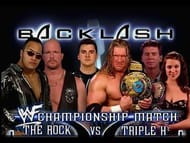
WrestleMania 2000 was a bit of a hot mess of a card, where only one match (a catfight between The Kat and Terri Runnels) was a true one-on-one affair; everything else was a mishmash of triple threats, fatal four-ways, and thrown-together tag matches, as well as a nonsensical Hardcore Battle Royal.
The WWF recognized the gold it had in some of those muddled matches and took two contests down to their best and most entertaining elements.
First was the triple threat match for the Intercontinental and European Championships from WrestleMania, where Chris Jericho took the European Title, while Chris Benoit walked away with the Intercontinental Title; Jericho would drop his belt to Eddie Guerrero soon after, then begin a career-defining feud with his fellow Canadian Chris for the Intercontinental Title.
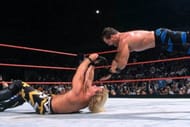
The "Chrises" had their first solo pay-per-view clash at Backlash, and showed flashes of the intensity that would make this feud one of the 2000s best; Jericho lost when, during a ref bump sequence, Y2J answered Benoit hitting the Manitoban with the belt by decking The Crippler with his own championship. It was at this point that referee Tim White came to, disqualified the Ayatollah of Rock and Rolla, and took a Walls of Jericho for his efforts.
What most people remember about Backlash 2000, however, is its main event, where The Rock, having been screwed out of the WWF Championship by company owner Vince McMahon and the rest of his fiendish family, got a one-on-one chance to take the belt from Triple H.
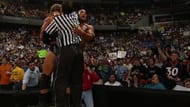
Featuring ref bumps, shenanigans from all McMahons involved, and the return of "Stone Cold" Steve Austin where, to deafening applause, he laid waste to the entire McMahon-Helmsley Era with a steel chair, the match saw its electrifying conclusion with Linda McMahon evening the odds by bringing Earl Hebner to cut through her family's scheming, allowing Rock to hit his spinebuster and People's Elbow to give fans the WrestleMania finish they truly wanted.
Which Worked Better?
Again, Backlash's rehashes were, undoubtedly, the better matches; Jericho and Benoit got more time than they had at Mania (time which they had to share with Kurt Angle and confusing stipulations), and a Rock vs. Triple H solo match was the WrestleMania main event crowds had been clamoring for.
#6. Backlash 2001: Ultimate Submission Match
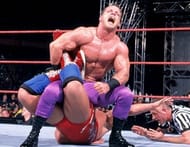
WrestleMania X-Seven featured a dream encounter for workrate marks all over the world: a highly-technical fourteen-minute clash of wrestling prowess between Kurt Angle and Chris Benoit. The pair was known for their technical acumen, as well as their submission finishers, WWF returned to the well a month later with its latest spin on the Iron Man Match, the Ultimate Submission Match.
This one going 30 minutes (instead of the original Iron Man's 60), Angle and Benoit fought each other to a 3-3 draw at the end of the original half hour. Referees would order an overtime, and this time Benoit would lock in the Crippler Crossface, to which Angle had already tapped once before. After about 90 seconds of overtime action, Angle submitted to the Crossface, giving the Canadian Crippler the win.
Which Worked Better?
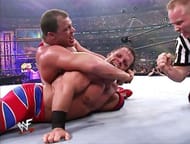
Conventional wisdom holds that taking a successful, if short, match and giving it more time to breathe would help improve that match; nearly every match we've looked at so far on this list takes that philosophy to correct some Mania mistakes at their next pay-per-view offering.
The Ultimate Submission Match, unfortunately, fails to live up to its predecessor; the intensity just does not match what the pair produced in Houston, and the removal of pinfalls takes away a great deal of each man's offense, as both were very adept at creative ways of forcing an opponent's shoulders to the mat.
Like with Bret and Austin, this isn't by any means a bad match, but it is a reminder that lightning usually does not strike twice, no matter how well you condition the environment to make it happen.
#5. Backlash 2004: Foley A-Tacks Orton and WWE doubles down on a Triple Threat
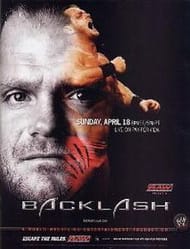
WrestleMania XX was billed as "Where it all begins...again," and was an above-average (if not a bit overlong) WrestleMania card; two memorable matches on the show, however, were not the blowoff one typically assumes WrestleMania to be, and carried on into April.
Evolution, consisting of Randy Orton, Ric Flair, and Batista, took on The Rock 'N' Sock Connection in a three-on-two handicap match, which Orton won for his team with a surprise RKO on Mick Foley; using the finish as ammunition on Orton's "Legend Killer" gimmick, The Viper would continue to antagonize the Hardcore Legend, until Foley demanded that Orton put his Intercontinental Championship on the line at Backlash in a Hardcore Match.
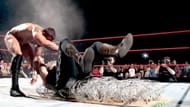
Often credited as the match which "made" Orton's career, The Legend Killer and ECW's legend, in his Cactus Jack persona, fought through barbed wire, thumbtacks, baseball bats, and buckets of blood en route to an RKO onto a barbed wire baseball bat; the enduring image of Orton's bloodied back full of push pins is often credited with helping Orton's case for his first World Heavyweight Championship, which he would win four months after this contest.
Meanwhile, the main event of WrestleMania XX was a bloody and chaotic encounter itself, which set the standard for main event Triple Threat matches and resulted in the then-cathartic crowning of Chris Benoit as World Heavyweight Champion after forcing Triple H to submit while Shawn Michaels stared down death by blood loss on the outer edges of the action.
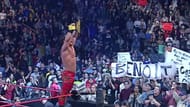
The trio refused to separate in the weeks after the Showcase of the Immortals, and entered Benoit's original billed hometown of Edmonton, Alberta, Canada, for a sequel to their classic clash; Canadian karma would get Michaels, as Benoit locked in the Sharpshooter on the Heartbreak Kid to force Michaels to tap out this time, allowing Chris Benoit to retain in his first pay-per-view defense of a world championship.
Which Worked Better?
In the case of Foley and Orton, the sequel undoubtedly eclipses the original; the WrestleMania handicap match was well worked and had some memorable spots, but Foley would cite its lack of a true "WrestleMania Moment," and its tepid reaction from Steve Austin backstage, as reasons for his return in his later hardcore clash with Edge. The Backlash match incorporates more intensity and eye-popping spots and is far more a star-maker for the third generation superstar than the March match allowed.
As far as the Triple Threat goes, it's a matter of personal preference as far as who you prefer to see tap out, and where; critical reception for the two matches was nearly identical, and proof that putting these three men together was a winning combination.
#4. Backlash 2005: The Beast stays The Best
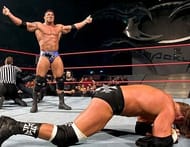
After 2004's SummerSlam event, where Randy Orton claimed his first World Heavyweight Championship from Chris Benoit, the dissolution of Evolution began, as Triple H famously, and unceremoniously, had Batista dump the youngest world champion in WWE history to signal an attack during Orton's championship celebration.
The "thumbs up to thumbs down" signal Helmsley used to trigger the attack came back to bite him, when Batista, having learned of a plot by The Game to have The Beast run over, opted to use his Royal Rumble win to challenge for the World Heavyweight Championship at WrestleMania 21, using the "thumbs-up-thumbs-down" callback to let Helmsley know that pain was in his future.
Batista took his first world championship when WrestleMania went Hollywood, and Triple H invoked his rematch clause for Mania's April followup; Batista would, once again, execute his Batista Bomb to The Game to retain his new title, but this time, Helmsley took out his frustrations on referee Mike Chioda, whom Triple H felt had failed to execute his duties properly during the contest. The WWE Draft later that year separated Batista and Helmsley later that year.
Which Worked Better?
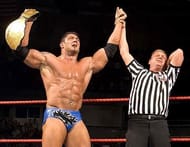
Like the Triple Threat in 2004, reaction to these two matches is a matter of personal preference; WrestleMania was more of an evenly-contested back-and-forth, while Backlash saw Helmsley employ every dirty trick learned from his mentor Ric Flair to stay competitive. Also, like the previous year's Backlash main event, critical reception for the two matches is nearly identical.
#3. Backlash 2007: Undertaker and Batista destroy each other
In the pantheon of "better than we thought" WrestleMania matches, Undertaker vs. Batista from WrestleMania 23 is at least an honorable mention; their later rematches would up the intensity, and the gimmickry, but the epic clash of WWE's hosses over the World Heavyweight Championship electrified Ford Field with massive throws and powerful strikes, in addition to an Undertaker staple at 2000s WrestleManias, the flying plancha.
In the end, the 2007 Royal Rumble winner Tombstoned The Beast to add another number to his streak, and take the World Heavyweight Championship, but Smackdown General Manager Theodore Long allowed Batista's contractual rematch to be contested at Backlash under the Last Man Standing rules, where the two superstars would battle until one man failed to get to his feet before a count of ten.
Undertaker and Batista picked up where they left off 28 days prior, but used the match's relaxed rules to add more spectacle and hardcore action to the contest; after an Undertaker leg drop put Batista through an announce table, the pair brawled up the entrance ramp until Batista took Taker down and off the entrance stage with his signature spear.
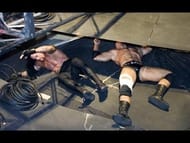
The intensity of the move, however, meant that neither man could answer the ten count, and the match was declared a draw, allowing Undertaker to retain the World Heavyweight Championhip, and ensuring far more destruction in the duo's future.
Which Worked Better?
For the third entry in a row, this one comes down to personal preference; many fans like the novelty of the WrestleMania match, and its stripped-down lack of gimmicks let the men focus on making moves matter. Fans of gaga and over-the-top action, though, prefer Backlash, and its dramatic spear off the stage provided a lasting and memorable image. Critics, likewise, are split, including Dave Meltzer, who rated the two matches an identical four stars.
#2. Backlash 2009: Edge is the Last Man Standing
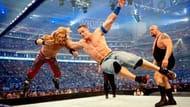
Edge found himself on the outs in a World Heavyweight Championship Triple Threat Match at WrestleMania XXV, forced to watch helplessly as John Cena pinned The Big Show to claim Edge's now-former title.
Like Batista before him, The Rated-R Superstar would invoke his rematch clause, which Vickie Guerrero would announce on RAW to be contested under Last Man Standing rules.
Edge recently remarked on his podcast his dismay that he and Cena never had their WrestleMania singles match, despite the number of classic encounters they'd shared throughout their feud, particularly this match and their Tables, Ladders, and Chairs encounter from 2006.
Backed into a corner by the stipulation which gave Super Cena a strong advantage, Edge manipulated the odds and brought back the third man from the WrestleMania triple threat, The Big Show, to tip the scales into the former Sexton Hardcastle's favor. Show delivered his Showstopper chokeslam to the leader of the Cenation into a spotlight near the entrance; Cena would be unable to return to his feet, or to consciousness, as John Cena would be stretchered out of the arena as Edge celebrated regaining the Big Gold Belt.
Which Worked Better?
Cena and Edge are sports entertainment magic when they tangle with one another, and the more they are able to focus on a one-on-one contest, the better; the Canadian and the New Englander added to their career highlight reel with a hard-fought brawl, and a highly entertaining and creative finish, to outdo the WrestleMania triple threat.
#1. Extreme Rules 2015: The Architect's first PPV defense
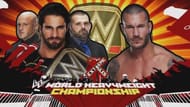
While WWE has repeated its WrestleMania main events numerous times to mixed (and, clearly, many times identical) results at the next pay-per-view event, our most recent entry onto this list bumped a mid-card match from WrestleMania 31 into the main event of Extreme Rules in the WWE Network's very next special.
Seth Rollins and Randy Orton squeezed a ton of effort and WrestleMania spectacle, in addition to, empirically, the single greatest RKO in history, into their Santa Clara encounter, and The Architect's Money in the Bank cash-in in the show's main event put a target on his back bigger than the belt on his waist.
First in line to take a shot was Randy Orton, who felt he was owed the first championship opportunity by virtue of being the last man to defeat the new champion (and on the same night he became champion, no less); each man won a match on RAW to choose the match's two stipulations, with Orton beating Tyson Kidd and Cesaro while Rollins beat a fellow Authority member with whom he had a feud slowly burning, Kane.
Orton picked a cage match with his stipulation and, in a move that made kayfabe sense but made no sense in the context of presenting entertaining fake fighting, Rollins opted to ban the RKO from the match; naturally, this meant that the RKO had to make an appearance in the match, the twist being that Rollins used the move to incapacitate Orton and allow himself to exit the cage and retain his new title.
Which Worked Better?
The WrestleMania 31 match was an instant classic for a number of reasons, the two biggest of which being Rollins's willingness to go all-out in his WrestleMania solo debut and the spectacular finish. The Architect's high-flying offense looked magnificent in a stadium setting, and it's impossible to heap too much praise on the acrobatic way the pair set up the winning RKO.
Extreme Rules' stipulations restricted all of that, with the cage walls taking away Rollins's ability to fly as easily and the removal of the RKO eliminating many fans' only reason to stick with a Randy Orton match; they worked well with what they were given, but couldn't match what they put on weeks prior at the Levi's Stadium.
Make Sportskeeda your preferred choice for WWE content by clicking here: Source preferences

